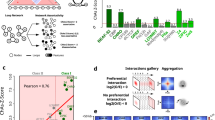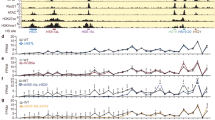Abstract
A cis-regulatory region of nearly 300 kb controls the expression of the three bithorax complex (BX-C) homeotic genes: Ubx, abd-A and Abd-B1,2. Interspersed between the numerous enhancers and silencers within the complex are elements called domain boundaries. Recently, many pieces of evidence have suggested that boundaries function to create autonomous domains by interacting among themselves and forming chromatin loops3,4,5,6. In order to test this hypothesis, we used Dam identification to probe for interactions between the Fab-7 boundary and other regions in the BX-C7. We were surprised to find that the targeting of Dam methyltransferase (Dam) to the Fab-7 boundary results in a strong methylation signal at the Abd-Bm promoter, ∼35 kb away. Moreover, this methylation pattern is found primarily in the tissues where Abd-B is not expressed and requires an intact Fab-7 boundary. Overall, our work provides the first documented example of a dynamic, long-distance physical interaction between distal regulatory elements within a living, multicellular organism.
This is a preview of subscription content, access via your institution
Access options
Subscribe to this journal
Receive 12 print issues and online access
$209.00 per year
only $17.42 per issue
Buy this article
- Purchase on Springer Link
- Instant access to full article PDF
Prices may be subject to local taxes which are calculated during checkout



Similar content being viewed by others
References
Lewis, E.B. A gene complex controlling segmentation in Drosophila. Nature 276, 565–570 (1978).
Maeda, R.K. & Karch, F. The ABC of the BX-C: the bithorax complex explained. Development 133, 1413–1422 (2006).
Muravyova, E. et al. Loss of insulator activity by paired Su(Hw) chromatin insulators. Science 291, 495–498 (2001).
Cai, H.N. & Shen, P. Effects of cis arrangement of chromatin insulators on enhancer-blocking activity. Science 291, 493–495 (2001).
Gerasimova, T.I., Byrd, K. & Corces, V.G. A chromatin insulator determines the nuclear localization of DNA. Mol. Cell 6, 1025–1035 (2000).
Gruzdeva, N., Kyrchanova, O., Parshikov, A., Kullyev, A. & Georgiev, P. The Mcp element from the bithorax complex contains an insulator that is capable of pairwise interactions and can facilitate enhancer-promoter communication. Mol. Cell. Biol. 25, 3682–3689 (2005).
van Steensel, B. & Henikoff, S. Identification of in vivo DNA targets of chromatin proteins using tethered dam methyltransferase. Nat. Biotechnol. 18, 424–428 (2000).
Galloni, M., Gyurkovics, H., Schedl, P. & Karch, F. The bluetail transposon: evidence for independent cis-regulatory domains and domain boundaries in the bithorax complex. EMBO J. 12, 1087–1097 (1993).
McCall, K., O'Connor, M.B. & Bender, W. Enhancer traps in the Drosophila bithorax complex mark parasegmental domains. Genetics 138, 387–399 (1994).
Bender, W. & Hudson, A. P element homing to the Drosophila bithorax complex. Development 127, 3981–3992 (2000).
Mihaly, J. et al. Chromatin domain boundaries in the Bithorax complex. Cell. Mol. Life Sci. 54, 60–70 (1998).
Gyurkovics, H., Gausz, J., Kummer, J. & Karch, F. A new homeotic mutation in the Drosophila bithorax complex removes a boundary separating two domains of regulation. EMBO J. 9, 2579–2585 (1990).
Mihaly, J., Hogga, I., Gausz, J., Gyurkovics, H. & Karch, F. In situ dissection of the Fab-7 region of the bithorax complex into a chromatin domain boundary and a Polycomb-response element. Development 124, 1809–1820 (1997).
Hagstrom, K., Muller, M. & Schedl, P. Fab-7 functions as a chromatin domain boundary to ensure proper segment specification by the Drosophila bithorax complex. Genes Dev. 10, 3202–3215 (1996).
Zhou, J., Barolo, S., Szymanski, P. & Levine, M. The Fab-7 element of the bithorax complex attenuates enhancer-promoter interactions in the Drosophila embryo. Genes Dev. 10, 3195–3201 (1996).
Zhou, J., Ashe, H., Burks, C. & Levine, M. Characterization of the transvection mediating region of the abdominal-B locus in Drosophila. Development 126, 3057–3065 (1999).
Barges, S. et al. The Fab-8 boundary defines the distal limit of the bithorax complex iab-7 domain and insulates iab-7 from initiation elements and a PRE in the adjacent iab-8 domain. Development 127, 779–790 (2000).
Zhou, J. & Levine, M. A novel cis-regulatory element, the PTS, mediates an anti-insulator activity in the Drosophila embryo. Cell 99, 567–575 (1999).
Chen, Q., Lin, L., Smith, S., Lin, Q. & Zhou, J. Multiple promoter targeting sequences exist in Abdominal-B to regulate long-range gene activation. Dev. Biol. 286, 629–636 (2005).
Muller, M., Hagstrom, K., Gyurkovics, H., Pirrotta, V. & Schedl, P. The mcp element from the Drosophila melanogaster bithorax complex mediates long-distance regulatory interactions. Genetics 153, 1333–1356 (1999).
Bantignies, F., Grimaud, C., Lavrov, S., Gabut, M. & Cavalli, G. Inheritance of Polycomb-dependent chromosomal interactions in Drosophila. Genes Dev. 17, 2406–2420 (2003).
Lebrun, E., Fourel, G., Defossez, P.A. & Gilson, E. A methyltransferase targeting assay reveals silencer-telomere interactions in budding yeast. Mol. Cell. Biol. 23, 1498–1508 (2003).
Sipos, L. et al. Transvection in the Drosophila abd-B domain. Extensive upstream sequences are involved in anchoring distant cis-regulatory regions to the promoter. Genetics 149, 1031–1050 (1998).
Siegal, M.L. & Hartl, D.L. Transgene Coplacement and high efficiency site-specific recombination with the Cre/loxP system in Drosophila. Genetics 144, 715–726 (1996).
Rorth, P. A modular misexpression screen in Drosophila detecting tissue-specific phenotypes. Proc. Natl. Acad. Sci. USA 93, 12418–12422 (1996).
Hogga, I., Mihaly, J., Barges, S. & Karch, F. Replacement of Fab-7 by the gypsy or scs insulator disrupts long-distance regulatory interactions in the Abd-B gene of the bithorax complex. Mol. Cell 8, 1145–1151 (2001).
van Steensel, B., Delrow, J. & Henikoff, S. Chromatin profiling using targeted DNA adenine methyltransferase. Nat. Genet. 27, 304–308 (2001).
Tremml, G. & Bienz, M. Homeotic gene expression in the visceral mesoderm of Drosophila embryos. EMBO J. 8, 2677–2685 (1989).
Celniker, S.E., Sharma, S., Keelan, D.J. & Lewis, E.B. The molecular genetics of the bithorax complex of Drosophila: cis-regulation in the Abdominal-B domain. EMBO J. 9, 4277–4286 (1990).
Martin, C.H. et al. Complete sequence of the bithorax complex of Drosophila. Proc. Natl. Acad. Sci. USA 92, 8398–8402 (1995).
Acknowledgements
We thank P. Rorth, B. van Steensel and S. Henikoff for providing plasmids, fly strains and advices. We are indebted to C. Barraclough, M. Docquier and P. Descombes of the NCCR Frontiers in Genetics genomics group for their advice and assistance in quantitative PCR. We also thank A. Mutero for her critical reading and comments on the manuscript. Finally, we wish to thank P. Verrijzer and H.Gyurkovics for stimulating discussions. This work was supported by the Swiss National Foundation, by the NCCR Frontiers in Genetics and by the State of Geneva.
Author information
Authors and Affiliations
Corresponding author
Ethics declarations
Competing interests
The authors declare no competing financial interests.
Supplementary information
Supplementary Fig. 1
Boundary tethering model. (PDF 344 kb)
Supplementary Table 1
Primers used in this study and their positions in the bithorax complex. (PDF 48 kb)
Supplementary Table 2
Summary of two-way ANOVA analysis. (PDF 68 kb)
Supplementary Table 3
Tables summarizing two-way ANOVA analysis. (PDF 76 kb)
Rights and permissions
About this article
Cite this article
Cléard, F., Moshkin, Y., Karch, F. et al. Probing long-distance regulatory interactions in the Drosophila melanogaster bithorax complex using Dam identification. Nat Genet 38, 931–935 (2006). https://doi.org/10.1038/ng1833
Received:
Accepted:
Published:
Issue Date:
DOI: https://doi.org/10.1038/ng1833
This article is cited by
-
Long range inter-chromosomal interaction of Oct4 distal enhancer loci regulates ESCs pluripotency
Cell Death Discovery (2023)
-
CRISPR/Cas9 and FLP-FRT mediated regulatory dissection of the BX-C of Drosophila melanogaster
Chromosome Research (2023)
-
DamC reveals principles of chromatin folding in vivo without crosslinking and ligation
Nature Structural & Molecular Biology (2019)
-
Functional role of dimerization and CP190 interacting domains of CTCF protein in Drosophila melanogaster
BMC Biology (2015)
-
Enhancer loops appear stable during development and are associated with paused polymerase
Nature (2014)



